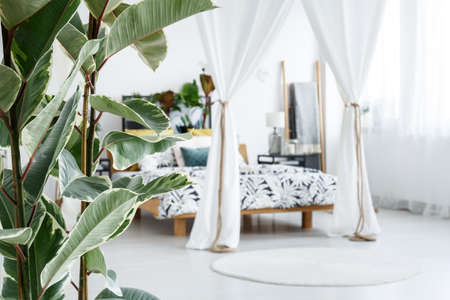1. Understanding Bedroom Feng Shui Basics
If you’ve ever wondered why some bedrooms feel instantly peaceful while others just don’t seem to offer the same comfort, Feng Shui might hold the answers. Feng Shui is an ancient Chinese practice that focuses on arranging your living spaces to promote good energy flow—also known as “chi”—which can help improve sleep and even enhance relationships. Let’s break down the key principles of Feng Shui as they apply to your bedroom so you can start creating a restful sanctuary.
What Is Energy Flow in Feng Shui?
In Feng Shui, energy flow is all about allowing positive vibes to move smoothly around your bedroom. Stagnant or blocked energy can make a space feel uncomfortable and disrupt both rest and romance. The goal is to design a room where energy can circulate freely, helping you feel relaxed and recharged.
The Importance of Furniture Placement
The way you arrange your bed and other furniture plays a huge role in how energy moves through your room. Here are some basic guidelines for optimal placement:
| Furniture | Feng Shui Placement Tips |
|---|---|
| Bed | Place your bed against a solid wall, ideally diagonally across from the door but not directly in line with it. This gives you a sense of security and control. |
| Nightstands | Use two matching nightstands on either side of the bed for balance, which symbolizes harmony in relationships. |
| Dresser/Closet | Keep these areas organized and clutter-free to allow smooth energy flow and reduce stress. |
| Mirrors | Avoid placing mirrors directly facing the bed, as they can reflect energy back at you and disturb sleep. |
Creating a Calm Environment
A peaceful bedroom environment sets the stage for better sleep and closer connections. Here are some simple tips:
- Choose soothing colors: Soft blues, greens, or earth tones promote relaxation.
- Minimize electronics: Try to keep TVs, computers, and phones out of the bedroom to limit distractions and electromagnetic fields.
- Add natural touches: Incorporate plants or artwork with nature scenes for grounding, but avoid sharp-leafed plants like cactus.
- Soft lighting: Use lamps with warm light bulbs instead of harsh overhead lighting to create a cozy atmosphere.
- Tidy up regularly: A clean, uncluttered room encourages clear thinking and restful sleep.
The Big Picture: Why Feng Shui Matters in Your Bedroom
Your bedroom should be your retreat—a place where you recharge your energy and nurture your relationships. By understanding the basics of Bedroom Feng Shui, you’re taking the first step toward turning your space into a true sanctuary.
2. Optimizing Layout and Furniture Placement
Arranging your bedroom furniture in a thoughtful way can make a big difference in how peaceful and inviting the space feels. Both Feng Shui principles and modern American design ideas agree that where you place your bed and other key items can influence your sleep quality, your mood, and even your relationships.
Bed Position: The Heart of Bedroom Feng Shui
In Feng Shui, the bed is considered the most important piece of furniture in your bedroom. The ideal spot is called the “command position,” which means placing your bed so you can see the door while lying down, but not directly in line with it. This helps you feel safe and supported, making it easier to relax and fall asleep.
Quick Bed Placement Guide
| Placement Tip | Feng Shui Reasoning | Western Design Perspective |
|---|---|---|
| Bed faces the door (but not directly in line) | Enhances security, reduces anxiety | Makes entering the room feel welcoming |
| No bed under windows | Avoids energy loss and lack of support | Reduces drafts, improves coziness |
| Bed against a solid wall | Provides strong backing/support | Adds stability to the room’s look |
| Space on both sides of the bed | Encourages balance in relationships | Makes getting in/out easier for couples |
Other Furniture: Balancing Function and Flow
Keep nightstands on both sides of the bed for balance—this works for singles too! Make sure dressers, desks, or lounge chairs don’t block natural pathways. If possible, avoid having mirrors face your bed, as this can feel unsettling at night for some people.
Simple Tips for Arranging Your Space
- Clear Clutter: Keep walkways open and tidy to reduce stress.
- Symmetry: Try to use pairs—like two lamps or two pillows—for harmony.
- Sitting Areas: If space allows, add a cozy chair or bench near a window for reading or relaxing.
- Work-Free Zone: If possible, keep work desks out of the bedroom to separate rest from productivity.
- Smooth Edges: Rounded furniture corners can soften the energy and prevent bumping into sharp edges at night.
Your Relaxation-Friendly Layout Checklist:
- Bed in command position with a clear view of the door
- No large furniture blocking windows or doors
- Balanced nightstands and lighting on both sides of bed
- Sufficient walking space around all furniture pieces
- No clutter under or around the bed area
A thoughtfully arranged bedroom layout blends comfort with positive energy flow. By combining Feng Shui wisdom with practical American home design, you’ll create a restful retreat that supports better sleep and happier relationships.

3. Choosing Colors and Lighting for Better Sleep
When it comes to bedroom Feng Shui, the colors and lighting you choose can make a big difference in how restful your space feels. In the United States, there’s a growing trend toward creating bedrooms that feel cozy, peaceful, and welcoming. By blending Feng Shui principles with popular American design preferences, you can create a sanctuary that supports both sleep and relationships.
How Colors Affect Mood and Relaxation
Colors have a powerful impact on our emotions and energy levels. According to Feng Shui, some colors promote relaxation and harmony, while others might feel too stimulating for a bedroom. Many American homes favor soft, calming tones that encourage rest and comfort.
| Color | Feng Shui Meaning | Popular Use in US Bedrooms |
|---|---|---|
| Soft Blues & Greens | Calmness, healing, peace | Very popular for creating a tranquil atmosphere |
| Warm Neutrals (Beige, Taupe) | Stability, comfort, grounding | Common choice for versatile, inviting spaces |
| Pale Pinks & Lavenders | Romance, gentle energy | Loved for adding warmth without overstimulation |
| Deep Reds & Bright Yellows | Passion (red), cheerfulness (yellow) | Used as accents only; too intense for full walls |
| Crisp Whites & Grays | Simplicity, clarity (but may feel cold if overused) | Often used as a base with colorful accents |
Tips for Choosing Bedroom Colors:
- Stick to cool or neutral tones for walls and bedding.
- Add color through pillows, artwork, or rugs if you want personality without overwhelming the senses.
- If you share your bedroom with a partner, discuss what colors help both of you feel relaxed and connected.
The Role of Lighting in Your Bedroom Sanctuary
Lighting also plays a key role in setting the mood for sleep and intimacy. In Feng Shui—and in most modern American bedrooms—the goal is to avoid harsh overhead lights and instead use softer layers of light that can be adjusted throughout the day.
Types of Lighting to Consider:
- Soft Overhead Lights: Choose fixtures with dimmers so you can control brightness.
- Bedside Lamps: Use warm-toned bulbs for reading or winding down at night.
- Candles or String Lights: Great for creating a cozy or romantic vibe without being too bright.
- Avoid Blue-Toned LEDs: These can interfere with your body’s natural sleep signals.
Lighting Tips from Feng Shui and American Design:
- Let natural light in during the day to boost mood.
- Avoid placing mirrors where they reflect light directly onto the bed—it can disturb restful energy.
- If possible, keep electronics and bright alarm clocks out of sight when you’re trying to sleep.
Selecting soothing color palettes and thoughtful lighting helps transform your bedroom into a true retreat—one that supports restful sleep and strengthens relationships by making everyone feel comfortable and at ease.
4. Decluttering and Personalizing Your Space
Why Decluttering Matters in Bedroom Feng Shui
One of the most important steps in creating a restful sanctuary is decluttering your bedroom. According to Feng Shui principles, clutter blocks the flow of positive energy—also known as “chi”—and can cause stress, anxiety, and restlessness. In American culture, many people already see tidying up as a way to boost mental health and create a calming environment. When you remove unnecessary items, you not only make your space look better but also help clear your mind for better sleep and improved relationships.
Benefits of Decluttering Your Bedroom
| Benefit | How It Helps |
|---|---|
| Mental Clarity | A tidy space makes it easier to relax and focus on what matters most. |
| Better Sleep Quality | Less visual distraction leads to a more peaceful environment for sleep. |
| Improved Relationships | A clean space reduces stress and supports open communication with your partner. |
| Positive Energy Flow | Feng Shui believes that clear pathways invite good energy into your life. |
Personalizing Your Bedroom for Emotional Connection
Your bedroom should reflect who you are and nurture the relationships that matter most. Adding personal touches, such as meaningful decor or photos that spark joy, can strengthen your emotional connection with yourself and your partner. In the U.S., its common to display favorite artwork, souvenirs from travels, or family photos—these items help make your space feel truly yours.
Ideas for Adding Personal Touches
- Photos: Frame happy memories or special moments together.
- Bedding: Choose colors or patterns that make you feel calm and cozy.
- Decorative Items: Use pieces that have special meaning or symbolize love and harmony.
- Aromatherapy: Add scents like lavender or vanilla for relaxation and comfort.
- Candles or Soft Lighting: Create a warm, inviting glow for intimacy and relaxation.
Quick Tips for Balancing Decluttering and Personalization
- Keep surfaces mostly clear but reserve space for one or two cherished items.
- Avoid overcrowding walls with too many pictures; select only the most meaningful ones.
- If sharing your bedroom, involve your partner in choosing decor so the space feels welcoming to both of you.
By decluttering and thoughtfully personalizing your bedroom, you set the stage for restful sleep and deeper connections with those you love—making your bedroom a true sanctuary for both body and spirit.
5. Feng Shui Tips for Strengthening Relationships
Bring Harmony and Connection to Your Shared Space
The energy in your bedroom can have a big impact on your relationship. If you want to create a loving and supportive atmosphere, these Feng Shui tips will help you make your bedroom a true sanctuary for both sleep and connection.
Symmetry: Create Balance for Couples
Symmetry is one of the easiest ways to invite harmony into a couple’s bedroom. When both partners have equal space and similar items on each side of the bed, it sends a message of equality and partnership.
| Element | Why It Matters | How to Add It |
|---|---|---|
| Matching Nightstands | Promotes balance and equality | Place one on each side of the bed with similar lamps or décor |
| Pillows & Bedding | Encourages shared comfort | Use pairs of pillows and keep bedding cohesive in color and style |
| Lamps | Supports equal lighting for both partners | Add identical lamps to each nightstand |
Artwork: Set the Mood for Love
The art you hang in your bedroom can influence the energy between you and your partner. Choose pieces that inspire romance, togetherness, or calm. Avoid artwork that shows single figures, conflict, or loneliness.
- Couples’ Art: Images of pairs, like two birds or abstract art representing unity, are ideal.
- Positive Vibes: Pick artwork with warm colors or peaceful scenes that make you both feel good.
- Avoid Solo Pieces: Skip art that features only one person or feels sad—Feng Shui favors symbols of partnership.
Create a Cozy Retreat Together
Your bedroom should be a place where both people feel safe, comfortable, and welcome. Think about these simple changes:
- Soft Lighting: Use dimmable lights or string lights to create a gentle atmosphere at night.
- Shared Blankets: Opt for oversized comforters or throws you can snuggle under together.
- Scent and Sound: Try calming scents like lavender or vanilla, and consider a white noise machine if outside sounds interrupt your rest.
- No Clutter Under the Bed: Keeping this area clear supports restful sleep and positive energy flow between you and your partner.
- Personal Touches: Display meaningful mementos from your relationship—photos, souvenirs, or love notes add warmth without cluttering the space.
Quick Reference Table: Feng Shui Must-Haves for Couples’ Bedrooms
| Item/Feature | Main Benefit |
|---|---|
| Matching Nightstands & Lamps | Balance & Equality |
| Cohesive Artwork of Pairs/Couples | Inspires Togetherness |
| No Electronics (TVs, Phones) | Keeps Focus on Each Other & Restful Sleep |
| Candles or Soft Lighting | Adds Warmth & Romance |
| Tidy, Clutter-Free Space | Makes Room Feel Calmer & More Inviting |
| Comfortable Bedding for Two | Supports Shared Comfort & Intimacy |
The right Feng Shui touches can turn your bedroom into a haven for intimacy and restful nights—a place where both you and your partner feel truly at home together.


